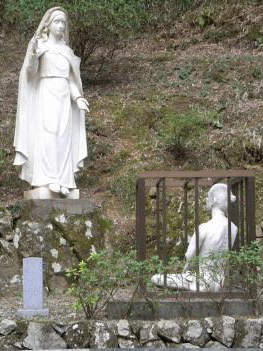(566) Nagasaki Kirishitan Rutakuhi Monument [調べる]
Please look at this picture. It reads Nagasaki Kirishitan Rutakuhi, meaning Nagasaki Christian exile Monument. The obelisk style monument is 3.5m high.
The front of the pedestal1) is bordered and engraved with the names of the eight dead. In front of this, two small old tombstones are enshrined.
1) pedestal: (円柱・彫像の)台座
The inscription says: in October of the first year of Meiji (AD 1868), more than 3,000 of us were exiled from Nagasaki for being Catholics. More than 100 of us were exiled to Matsuyama. We endured three and a half years of hard labor, including being forced to apostatize2) in a three-foot prison, during which time eight of us returned to heaven.
2) apostatize: (信仰、党などを)捨てる、脱する
 REPLICA THREE-FOOT PRISON
REPLICA THREE-FOOT PRISON(The statue of Yasutaro in the replica "three-foot prison" installed at Otome Pass in Shimane prefecture and the statue of the Virgin Mary who descended.)
I was shocked to know of the monument because this exile occurred in the Meiji era. I knew tortures against Christians in the Edo era, about 400 years ago. The system of shogunate was based on the class system. It ranks Samurai at the top, followed by peasants, craftsmen and merchants. The Christian principle of equality didn't go with this rank system. The new government, Meiji government abolished the class system of the Edo period, and ensured the equality of all people. But it took five more years to abolish the prohibition of Christianity. In 1873, it was done because of the pressure from foreign countries, not of understanding freedom of religion.
The reality of these tortures against Christians was reported in Western countries through foreign missions. This led to an outpouring3) of international public opinion. It harshly condemned4) the Meiji government for oppressing5) believers of the same religion as themselves.
3) outpouring: (感情の)ほとばしり
4) condemn: 責める、避難する
5) oppress: ・・・を迫害する
3) outpouring: (感情の)ほとばしり
4) condemn: 責める、避難する
5) oppress: ・・・を迫害する

Nighnteen years later, in 1892, the 24th year of the Meiji, an American came to Matsuyama as an English teacher of the Japanese government Middle school. He was a Methodist, kind of Protestant. He wrote in his diary about Roman Catholic Christians of the Edo period in Japan.
He said, "It seems, however, that much of the evil that befell these early Roman Catholic Christians resulted from the effort to establish Christianity as the State religion."
I think, he wanted to say that even Christianity should not be the State religion.
Lastly, I am happy to say this.
Today's Japan's constitution mentions about freedom of religion. Article 20. Freedom of religion is guaranteed to all. No religious organization shall receive any privileges from the State, nor exercise any political authority.
信教の自由は、何人にたいしてもこれを保障する。いかなる宗教団体も、国から特権を受け、又は政治上の権力を行使してはならない。
*




コメント 0